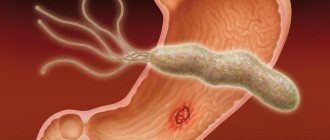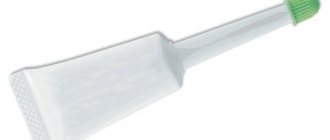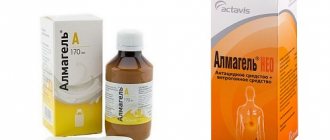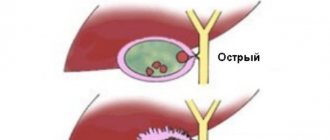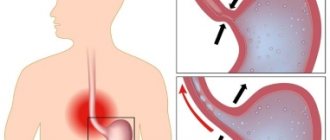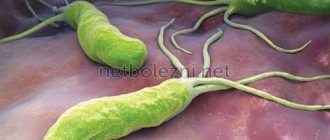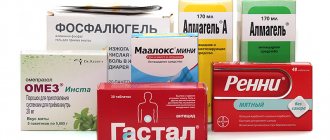Modern drugs for the treatment of ulcers
Peptic ulcer of the stomach and duodenum still remains one of the most common gastrointestinal problems. In recent years, approaches to the treatment of ulcers have gradually changed due to outstanding achievements in microbiology, physiology and anatomy.
What is an ulcer
The morphological substrate - an ulcer - is a defect in the mucous membrane, which is formed under the aggressive influence of gastric contents against the background of a reduced ability of the mucous membrane to restore and protect itself. All areas of therapy come down to eliminating these factors of aggression and increasing the protective properties of the mucosa.
Proton pump inhibitors and their effects
In the treatment of ulcers, the problem of high acidity comes first, and ways to solve this problem were developed decades ago, after the discovery in 1973 of a special protein “pump” - a proton pump that supplies hydrogen protons for the formation of hydrochloric acid in the stomach.
Prospects and problems of anti-Helicobacter therapy
A.A. SAMSONOV, Professor of the Department of Propaedeutics of Internal Diseases and Gastroenterology of Moscow State Medical University, Doctor of Medical Sciences
N.N. GOLUBEV, assistant at the Department of Propaedeutics of Internal Diseases and Gastroenterology, Moscow State Medical University, Candidate of Medical Sciences
The discovered microorganisms were initially classified as bacteria close to the genus Campylobacter jejuni and received the name Campylobacter pyloridis, and in 1989? These microorganisms were isolated into an independent genus Helicobacter and officially renamed Helicobacter pylori (HP), since the latter had only a distant resemblance to Campylobacter.
The discovery of HP overturned the existing ideas about the etiopathogenesis of gastric and duodenal ulcers, active chronic antral (type B) and atrophic gastritis. The mechanisms of pathogenesis of non-cardiac cancer and gastric MALT lymphoma have been significantly clarified. Its global significance is also evidenced by the fact that Marshall and Warren were awarded the Nobel Prize in Medicine and Physiology in 2005 for “the discovery of the HP bacterium and the study of its role in gastritis and stomach ulcers.”
The results of numerous studies have allowed practitioners to reach a qualitatively new level of implementation of the principles of prevention, diagnosis and treatment of these common diseases of the upper gastrointestinal tract (GIT). The most important achievements include the real possibility of curing peptic ulcers and chronic gastritis, as well as the development of preventive measures for most cases of stomach cancer.
The problem of HP-associated gastrointestinal diseases and, first of all, peptic ulcer disease is very relevant for our country, where at least 8% of the population suffers from this pathology. In general, Russia is one of the countries with a high level of infection with the HP bacterium. Timely diagnosis and treatment of this infection is the only correct way to solve the problem of preventing gastrointestinal diseases, including such dangerous ones as stomach cancer.
Recognition of the importance of an infectious agent in the pathogenesis of peptic ulcers and chronic gastritis has brought to the fore, in addition to the previously widely used cytoprotectors and antisecretory agents (primarily proton pump inhibitors, PPIs), anti-Helicobacter therapy based on antibacterial drugs, aimed at the complete destruction of vegetative and coccal forms HP in the gastrointestinal mucosa.
Today, anti-Helicobacter therapy is considered the main standard of treatment for HP-associated diseases, which is reflected in the international European (Maastricht Agreements I, II, and III) and Russian clinical guidelines for the treatment of gastroenterological patients.
With regard to peptic ulcer disease, successful eradication of HP contributes to long-term remission of the disease, prevention of complications and prevention of their re-development, while without appropriate therapy, most patients experience relapse within the first year.
Currently, the main indications for diagnosing HP infection and conducting anti-Helicobacter therapy are:
Peptic ulcer of the stomach and duodenum:
- exacerbation stage
- documented history of peptic ulcer (beyond exacerbation)
- immediately after ulcer bleeding or when a history of bleeding is indicated
- after surgical treatment, incl. about complications.
Cancer prevention of the stomach:
- atrophic gastritis (eradication of HP stops the spread of atrophy and can lead to its regression)
- after gastric resection for cancer
- in 1st degree relatives of patients suffering from, undergoing surgery or dying from stomach cancer
- MALT lymphoma of the stomach
- in a population at high risk of developing gastric cancer.
Other indications:
- functional dyspepsia (is an acceptable treatment strategy and in some patients leads to long-term improvement in well-being)
- Diagnosis and treatment of HP infection should be planned when:
- long-term use of non-steroidal anti-inflammatory drugs (NSAIDs) and acetylsalicylic acid (however, eradication therapy is not sufficient to prevent NSAID-associated ulcers),
- long-term use of PPIs (for example, in patients with gastroesophageal reflux disease)
- idiopathic iron deficiency anemia (after careful exclusion of other possible causes)
- idiopathic thrombocytopenic purpura
- the patient’s desire, including for the implementation of gastric cancer prevention.
In general, the principles of treatment of HP infection have not changed significantly over the past ten years. The III Maastricht Agreement recommends the use of standard combinations of antibiotics with PPIs and bismuth preparations, distinguishing first- and second-line treatment regimens.
Anti-Helicobacter therapy is usually started with a first-line PPI-based regimen: PPI in a standard dose in the morning and evening before meals (rabeprazole, omeprazole and esomeprazole 20 mg 2 times a day, lansoprazole 30 mg 2 times, pantoprazole 40 mg 2 times) , amoxicillin 1000 mg 2 times a day and clarithromycin 500 mg 2 times a day with meals. It is possible to replace the PPI with ranitidine bismuth citrate at a dose of 400 mg 2 times a day.
In the III Maastricht Agreement, it is recommended that the duration of treatment be increased to 14 days, which significantly increases the effectiveness of eradication by 12% and, equally important, reduces the likelihood of developing secondary HP resistance to clarithromycin. According to our data, a two-week treatment regimen can increase the rate of successful HP eradication by 13.3%. At the same time, in regions with preserved sensitivity to the components of eradication therapy, which should be confirmed by high-quality “local studies,” a 7-day treatment cycle remains acceptable in clinical practice.
This triple regimen provides a high level of HP eradication (85-90%), is usually well tolerated by patients, is safe, and provided that Helicobacter pylori infection is successfully suppressed, the percentage of relapses of duodenal ulcer is reduced to 5 or less cases per year. As for the frequency of reinfection after successful anti-Helicobacter therapy, it is 1.2-4.2% and 7.6-13.0% over twelve months in developed and developing countries, respectively. The appearance of bacteria in the patient’s body a year after treatment is regarded as a relapse of infection (and not reinfection) and requires the appointment of a more effective eradication regimen.
According to the recommendations of the III Maastricht Agreement, a regimen consisting of PPI, clarithromycin and Metronidazole can be used as first-line therapy, especially in patients with hypersensitivity to penicillin antibacterial drugs. The use of this combination is possible if the resistance of the most common HP strains in a given region to Metronidazole does not exceed 40%. Unfortunately, in Russia this threshold has been exceeded due to the widespread and often uncontrolled use of Metronidazole. The resistance of Helicobacter pyloricus to this antibiotic is about 55%, which makes its use as part of a first-line triple eradication regimen impractical.
If triple anti-Helicobacter therapy is ineffective (no eradication of HP 4-6 weeks after complete discontinuation of antibiotics and antisecretory drugs), repeating the first-line regimen is not recommended, since there is a high probability that the patient has a strain resistant to clarithromycin. In this case, as a rule, second-line quadruple therapy is performed based on a bismuth drug: bismuth tripotassium dicitrate 480 mg per day (120 mg 4 times a day or in two doses of 240 mg in the morning and evening), tetracycline 500 mg 4 times a day and Metronidazole 500 mg 3 times a day for 10 days. At the same time, the inclusion of tripotassium dicitrate in the bismuth eradication scheme makes it possible to overcome the resistance of Helicobacter pylorus to Metronidazole.
At the same time, according to the recommendations of the III Maastricht Consensus, the use of alternative first-line therapy to the standard four-component regimen based on bismuth is indicated if HP resistance to clarithromycin in the region exceeds 20% or the patient has hypersensitivity to amoxicillin or clarithromycin. At the same time, the effectiveness of tri- and quadruple therapy regimens is approximately the same and amounts to 85 and 87%, respectively. However, this regimen, despite the good evidence base for its effectiveness, also has a number of significant disadvantages, which include a difficult four-times-daily regimen for patients, the need to take a significant number of tablets, and a fairly large number of side effects.
Speaking about the level of HP resistance to clarithromycin, it should be noted that, according to large studies, in northern Europe it is at the level of 5-15%, while in southern Europe this figure is already 21-28%. In Turkey, resistance to clarithromycin is already registered in 44-48% of patients. In China, the percentage of clarithromycin-resistant HP strains is 18.5%. In the USA in 1999-2003. the number of patients with Helicobacter-associated diseases contaminated with clarithromycin-resistant strains of HP was 10-12%, but in Alaska this figure was at the level of 31%.
In Russia, the 20% threshold of resistance to clarithromycin has not yet been overcome, which makes it possible to maintain triple therapy based on clarithromycin as a first-line eradication regimen. In the future, when the level of primary resistance in certain regions does not allow the use of first-line drugs, in particular clarithromycin, anti-Helicobacter therapy will need to begin with a four-component bismuth-based regimen.
If for some reason bismuth cannot be prescribed as a second line of eradication, triple therapy regimens may be used, including a standard dose PPI, amoxicillin 1000 mg twice daily in combination with tetracycline (500 mg four times daily), or furazolidone (200 mg 2 times a day).
If the use of one and then another treatment regimen does not lead to eradication of HP, the sensitivity of the bacterial strain to all antibiotics included in the eradication regimen should be determined.
Despite the fact that anti-Helicobacter therapy has been well studied and standardized, there are a number of problems in this area that require solutions. The greatest concern, both in Russia and abroad, is the decrease in the effectiveness of first-line therapy. First of all, this is due to a fairly rapid increase in HP resistance to antibiotics. According to some data, about a third of cases of lack of eradication are associated with the presence of resistance to clarithromycin. In the presence of a clarithromycin-resistant strain of bacteria, the likelihood of successful eradication with standard first-line therapy is reduced. At the same time, the materials that have appeared in the literature about the successful overcoming of resistance to clarithromycin by adding bismuth drugs to the first-line regimen are encouraging.
HP resistance to antibiotics is divided into primary, which is always a consequence of previous treatment with a macrolide antibiotic for another nosology, and secondary. Secondary resistance is caused by an acquired mutation of the microorganism during eradication therapy. The main reasons for the emergence of acquired resistance to clarithromycin include an increase in the number of patients taking inadequate anti-Helicobacter therapy, low doses of antibacterial agents, short courses of therapy, incorrect combination of drugs in the regimen and uncontrolled independent use of antibacterial drugs by patients for other indications during treatment.
The mechanism of formation of Helicobacter pyloric resistance to clarithromycin is the appearance of mutations leading to conformational changes in the ribosomes of the bacterial cell, which are the targets of the antibiotic.
Today, the main ways to prevent and overcome HP resistance are:
- adequate treatment using standard regimens for patients being treated for the first time
- use of bismuth-based quadruple therapy in regions with high levels of clarithromycin resistance
- conducting family therapy to eliminate the exchange of resistant strains
- changing the strategy for treating HP infection using reserve antibiotics
- determining the sensitivity of HP to antibiotics before prescribing therapy (which is not yet possible in Europe and the USA, as well as in Russia)
- development and use of therapeutic vaccines.
The use of four-component regimens based on bismuth is significantly more effective in comparison with triple therapy in the presence of clarithromycin-resistant strains, but requires taking a large number of drugs according to a rather complex regimen, which often significantly reduces the patient’s adherence to treatment. And low compliance is the second most common factor in unsuccessful therapy. They tried to solve this problem by creating a complex product containing a bismuth drug, tetracycline and Metronidazole in one capsule. Clinical trials on its use in combination with PPIs, conducted in the USA and Europe, showed high results. The percentage of eradication during the ten-day course was 87.7-93%. Unfortunately, this drug combination has not yet been registered in Russia.
Another encouraging innovative approach to anti-Helicobacter therapy is the so-called sequential therapy, developed in Italy. The course of treatment lasts 10 days. In this case, for the first 5 days the patient receives a PPI in a standard dose 2 times a day and amoxicillin 1000 mg 2 times a day, and for the next 5 days triple therapy consisting of a PPI, clarithromycin (500 mg 2 times) and tinidazole (500 mg 2 times ). The prerequisites for creating such a scheme were data obtained back in the mid-nineties of the last century. Then it was shown that the effectiveness of second-line anti-Helicobacter therapy after a failed first course was higher if fourteen-day dual therapy with PPI and amoxicillin was prescribed as the first line, and standard seven-day therapy as the second, than if these regimens were prescribed in reverse ok.
A series of seven studies conducted by Italian and Spanish authors, each including at least 100 patients, showed very promising results. The eradication rate with good treatment tolerance was 91-95%. It should be taken into account that the work was carried out in a region with a high level of HP resistance to clarithromycin.
In a comparative study of the effectiveness of ten-day courses of standard and sequential therapy, the latter showed a significantly better eradication percentage (78 and 91%, respectively). Moreover, sequential therapy has been shown to be effective against clarithromycin-resistant HP strains. The success of anti-Helicobacter therapy was achieved in 82-89% of patients using a sequential regimen and only in 29-44% of patients receiving standard triple therapy.
The exact reasons for this high performance are not entirely clear. It is assumed that taking amoxicillin reduces the degree of bacterial contamination of the mucous membrane of the upper gastrointestinal tract, thereby increasing the effectiveness of the combination of clarithromycin and tinidazole. It is also possible that amoxicillin, by disrupting the synthesis of the HP cell wall, prevents the appearance of membrane channels in it, through which the active removal (efflux) of clarithromycin from the microbial cell can occur.
In the future, new large studies are needed to study this promising option of anti-Helicobacter therapy, which will allow us to establish the exact place of the sequential scheme in the system of the first and second line of eradication.
In the last few years, the literature has actively discussed options for clinician tactics that differ from the classic quadruple therapy recommended by the Maastricht Agreement III in the event of failure of the initial treatment of HP infection.
In general, three options are possible:
- Carrying out sequential therapy
- Carrying out “rescue” therapy, which can also be used if eradication has not been achieved after two courses of treatment (third line)
- Selection of therapy depending on the results of determining the sensitivity of HP to antibiotics.
If clarithromycin was included in the first-line regimen, it should not be included in second-stage therapy. The exception, apparently, is sequential therapy, the results of which suggest the possibility of overcoming resistance to this antibiotic.
Three possible ten-day treatment regimens are discussed as a rescue therapy. To PPI (standard dosage 2 times a day) and amoxicillin (1000 mg 2 times a day) add levofloxacin (250 mg 2 times a day), or furazolidone (200 mg 2 times a day), or rifabutin (150 mg 2 times a day).
In our opinion, the most studied and promising, including for Russia, is a regimen that includes levofloxacin, which, compared to four-component therapy, is easier to tolerate and leads to successful eradication in 81-87%, and when replacing amoxicillin with tinidazole - in 84%. cases. At the same time, a ten-day treatment regimen is superior to a seven-day one, and a dose of 500 mg is as effective as 1000 mg.
Second-line therapy with furazolidone has been less studied, but is less expensive compared to other salvage regimens. HP eradication when used, according to various sources, ranges from 52 to 90%.
A regimen using rifabutin is effective in 74–91% of patients, but rifabutin is significantly inferior to levofloxacin as a basis for third-line therapy and can cause a number of serious side effects. In addition, rifabutin is used in the treatment of tuberculosis and in our country, for obvious reasons, its use as an anti-Helicobacter drug is inappropriate.
When determining the sensitivity of HP to antibiotics, today the resistance of this bacterium to clarithromycin is of greatest clinical importance. Recently, a number of molecular diagnostic methods have been proposed to detect mutations leading to its development. Among the most promising, noteworthy is the method of determining specific sequences on ribosomal deoxyribonucleic acid using the polymerase chain reaction, which, in addition to identifying resistance, can also be used as an effective method for diagnosing helicobacteriosis in the study of biopsies of the gastric mucosa and feces.
In conclusion, it must be said that currently in Russia the most effective and safe method of treating Helicobacter-associated diseases remains the first-line triple regimen, provided that it is prolonged to 14 days. In the future, a more detailed study of new reserve eradication regimens will make it possible to determine their place and significance in anti-Helicobacter therapy.
DRUG THERAPY AND PREVENTION OF EXCERNSATIONS AND COMPLICATIONS OF Peptic Ulcer
The paper briefly outlines recent views of the pathogenesis of peptic ulcer, underlines the need for eradication of Helicobacter pylori infection to prevent recurrent ulcers and complications, including ulceratve hemorrhage, gives drug regimens and comparatively evaluates various drugs used in peptic ulcer.
Chief gastroenterologist of the Russian Ministry of Health prof. P.Ya. Grigoriev, RGMU Prof. P.Ya. Grigoryev, Russian State Medical University, Head Gastroenterologist, Ministry of Health of the Russian Federation
Introduction
According to morbidity registration data, every 10th adult resident of Russia suffers from one or another disease of the digestive system. In some regions, the incidence rate significantly exceeds the national average. Peptic ulcer disease (PU) and its accompanying chronic active gastroduodenitis (CAGD) are especially widespread and ubiquitous among adults and even children. Of the ulcer patients under dispensary observation, every 9th is admitted to the hospital due to complications that arise (ulcer bleeding, ulcer perforation, etc.), for which most patients undergo surgery for health reasons. About 6,000 people of working age die annually in Russia from complications associated with inadequate drug treatment of patients with ulcerative disease. For more than 100 years, doctors were sure that ulcers arise from stress, as a result of eating disorders, smoking, drinking strong alcoholic drinks and under the influence of family history. Later it was found that ulcers in the mucous membrane (MU) of the stomach and duodenum are formed as a result of the predominance of aggressive factors (mainly hydrochloric acid and pepsin) over the protective factors of the gastroduodenal OM (secretion of mucus and bicarbonates, local synthesis of prostaglandins, sufficient regeneration of the integumentary epithelium, preserved blood supply, etc.). In fact, it turned out that the strengthening of endogenous factors of aggression (excessive acid formation) and the weakening of gastroduodenal CO resistance (gastritis, duodenitis) are caused by the colonization of the stomach and duodenum by spiral-shaped bacteria, called Helicobacter pylori (HP). It has now become clear that the main principle of drug therapy for gastric ulcer (GPU) and duodenal ulcer (DU) should be the mandatory use of drugs with anti-acid and antibacterial (anti-Helicobacter) activity. In addition, it was found that without the destruction (eradication) of the HP infection, complete and stable remission of ulcer does not occur. Factors that make it difficult to eliminate Hp infection of the gastric and duodenal mucosa include: failure of the patient to comply with doctor’s instructions regarding the medication regimen, development of Hp resistance to the drug used, smoking, significant severity of the inflammatory process in the gastroduodenal mucus and an inadequate combination of drugs used for eradication HP.
Treatment
It has been established that under the influence of a modern anti-acid drug, used in an adequate dose, the symptoms of the disease are relieved, ulcers are scarred in a short time, the side effects of antibacterial drugs are weakened, but the activity and infection of Helicobacter bacteria remain, and the eradication of HP with the help of an adequate combination of medications ensures a relapse-free course Peptic ulcer, regression of gastritis and duodenitis, as well as prevention of lymphoma and stomach cancer. Anti-acid drugs
| A drug | Dose | Duration of treatment |
| Omeprazole | 20 mg 2 times a day at 8 a.m. and 8 p.m. 20 mg 1 time a day at 8 a.m. as monotherapy | 7-10 days for the period of antibacterial therapy, 8 weeks for PU and 6 weeks for DU after the end of antibacterial therapy |
| Ranitidine | 150 mg 2 times a day at 8 and 20 o'clock, 300 mg once a day at 20 o'clock as monotherapy | 7-14 days for the period of antibacterial therapy 12 weeks for PU and 8 weeks for DU after the end of antibacterial therapy |
| Famotidine | 20 mg 2 times a day at 8 a.m. and 8 p.m. 40 mg once a day at 8 p.m. as monotherapy | 7-14 days for the period of antibacterial therapy 12 weeks for PU and 8 weeks for DU after the end of antibacterial therapy |
| Note: Omeprazole and other proton pump blockers (pantoprazole, lansoprazole) are 15-20% more effective than H2 receptor blockers in the treatment of ulcers. | ||
Among anti-acid drugs, the use of a proton pump blocker (omeprazole) or an H2 receptor blocker (ranitidine or famotidine) according to the schemes presented in the table is justified. WHO experts include metronidazole, clarithromycin, amoxicillin, tetracycline and colloidal bismuth subcitrate (CBS) in the list of drugs with anti-Helicobacter activity. Metronidazole
is the basis of three- and two-drug combinations used to treat Hp infection.
There is evidence of bacterial resistance to metronidazole, especially in cases where the drug is prescribed in small doses and as monotherapy. Metronidazole is prescribed 0.25 g 4 times or 0.5 g 2 times a day with meals for 7-14 days. Clarithromycin
inhibits bacterial protein synthesis and is therefore effective against HP.
When using the drug as monotherapy, HP sometimes develops resistance to it. Prescribe 0.25 g or 0.5 g 2 times a day between meals for 7 days. HP is also sensitive to amoxicillin
, which inhibits the synthesis occurring in the bacterial cell wall.
The bactericidal activity of the drug increases at neutral pH values. The drug is prescribed 0.5 g 4 times a day or 1 g 2 times a day between meals for 7-14 days, depending on the combination. Tetracycline
has a bactericidal effect on HP due to the suppression of protein synthesis in the bacterial cell.
The drug is active at low pH values. Bacterial resistance to the drug does not occur. Prescribed 0.5 g 4 times or 1 g 2 times a day with meals, course 10-14 days. Bismuth compounds
, especially SWS, are topical antimicrobials. They prevent the adhesion of HP to the epithelium and destroy the integrity of the bacterial wall. Large doses of bismuth compounds can be toxic to the central nervous system. Bismuth preparations are prescribed in combination with other drugs, 120 mg 4 times or 107 mg 5 times a day. Take on an empty stomach, 30 minutes before meals and 2 hours after meals for 10-14 days. When using various treatment regimens using these drugs, the frequency of eradication of Hp infection is usually 80 - 70%. In the group of patients who received SWR, metronidazole, tetracycline and omeprazole for 10 days, the frequency of Hp eradication reaches 95% or more. Similar results in HP eradication are observed with 7-day therapy with omeprazole in combination with clarithromycin and metronidazole. Instead of omeprazole, you can use ranitidine or famotidine in combination with two or three anti-Helicobacter drugs (metronidazole or amoxicillin + clarithromycin; SWR + tetracycline + metronidazole). Omeprazole and other proton pump blockers are more effective than H2 receptor blockers in the treatment of ulcers. When prescribing antibacterial therapy, it should be borne in mind that its effectiveness in terms of HP eradication when using these combinations in most cases reaches 70% or more, but is significantly reduced with monotherapy, bacterial resistance to the drug included in the combination, as well as if the patient does not comply with the regimen taking medications.
Treatment program for patients with peptic ulcer
The treatment program for patients with ulcer associated with HP includes:
- training patients in order to achieve partnership in treatment and increase responsibility for following the doctor’s recommendations (compliance with diet and medication, stopping smoking, etc.);
- assessment of the severity of ulcerative disease, taking into account medical history, clinical and endoscopic manifestations, tests for HP and the results of previous therapy;
- development of an individual plan for a course of anti-Helicobacter and anti-acid therapy, prolonged and intermittent therapy “on demand” for the prevention of complications, including ulcer bleeding.
For peptic ulcer complicated by bleeding, along with endoscopic control of bleeding (diathermocoagulation, etc.), intravenous infusions of omeprazole (40 mg in 100 ml of saline solution) or ranitidine (100 mg in 100 ml of saline solution) are necessary. In the absence of contraindications, oral administration of the appropriate anti-acid drug in combination with anti-Helicobacter therapy is immediately started. If oral administration of these drugs due to severe dyspeptic disorders turns out to be impossible, then it is necessary to continue infusion administration of one of the presented anti-acid drugs with an interval of 8 hours. Indications for prescribing a combination of anti-acid and anti-Helicobacter drug treatment are not only peptic ulcer and peptic ulcer associated with HP, but and reflux esophagitis, combined with Helicobacter gastritis and duodenitis, recurrent dyspepsia associated with Hp infection in patients operated on for ulcer. Thus, for the first 7 to 14 days, a patient with these diseases is usually prescribed an anti-acid drug twice a day in half the daily dose in combination with anti-Helicobacter pylori drugs, then for several weeks the patient takes only an anti-acid drug. This does not exclude the use of any antacid drug as a symptomatic remedy. The widespread implementation of modern principles and regimens of drug therapy for peptic ulcers and peptic ulcers can ensure a relapse-free course of the disease and prevent the development of life-threatening complications. For this purpose, it is advisable to use the following drug combinations.
| 1. SWR 120 mg 4 times a day. + metronidazole 250 mg 4 times a day + tetracycline 0.5 g 4 times a day. The course of treatment is 14 days. |
A combination drug gastrostat is also used, containing bismuth subcitrate (108 mg tablets), metronidazole (200 mg tablets) and tetracycline hydrochloride (250 mg tablets). At the same time, take 3 tablets 5 times a day at equal intervals for 10 days (a variant of the classic “triple” therapy). In order to more quickly relieve the symptoms of the disease, weaken adverse reactions and provide prolonged therapy, it is recommended to additionally prescribe gastrocepin 50 mg 2 times a day for CAHD for 10-14 days, for DU for 6 weeks, for PU for 12 weeks. The eradication rate of HP infection using this combination reaches 80%. For PU and PUD, during the first 7 days it is recommended to use omeprazole, which is prescribed 20 mg 2 times a day (at 8 and 20 o'clock). Thanks to the inclusion of omeprazole in this classic combination, not only does the effectiveness of treatment increase (the frequency of Hp eradication in gastroduodenal mucosa is up to 70% or more), but also the patient’s tolerance to drug therapy improves, the symptoms of the disease quickly stop and a more complete remission of gastroduodenitis occurs.
| 2. Ranitidine 150 mg 2 times a day or famotidine or omeprazole 20 mg 2 times a day for the first 7 days, then for 8 weeks for PUD, for 12 weeks for PUD one of the four indicated drugs is taken 1 time per day (ranitidine 300 mg, famotidine 40 mg at 20 o'clock, omeprazole 10 - 20 mg at 8 o'clock) + clarithromycin 250 mg 2 times a day + metronidazole 250 mg 4 times a day. The duration of the main course is 7 days. |
This treatment regimen for ulcer associated with HP ensures high efficiency in eliminating gastroduodenal OM infection (70% or more). This combination, unlike classical triple therapy, is better tolerated by patients. In exceptional cases, clarithromycin can be replaced with amoxicillin or oxacillin (500 mg 4 times a day for 7 days), and metronidazole with tetracycline (500 mg 4 times a day for 7 days), but in this case, as a rule, the eradication frequency HP is reduced to 80 - 85%. When using this combination, the frequency of Hp eradication was usually 15-20% higher in patients receiving omeprazole than in those taking an H2-receptor blocker. A course of drug therapy for exacerbation of ulcers not associated with HP (observed in ulcerative gastritis no more often than in 20% of cases, and in case of peptic ulcer not more often than in 1% of cases) includes ranitidine (300 mg/day) or famotidine (40 mg/day) in combination with an antacid drug.
Literature:
1. Grigoriev P.Ya., Yakovenko A.V. Reference Guide to Gastroenterology. M., 1997. - 410 p. 2. Loginov A.S. and others. Peptic ulcer and HP: new aspects of pathogenetic therapy. M.: Medicine, 1993. - 230 p.


